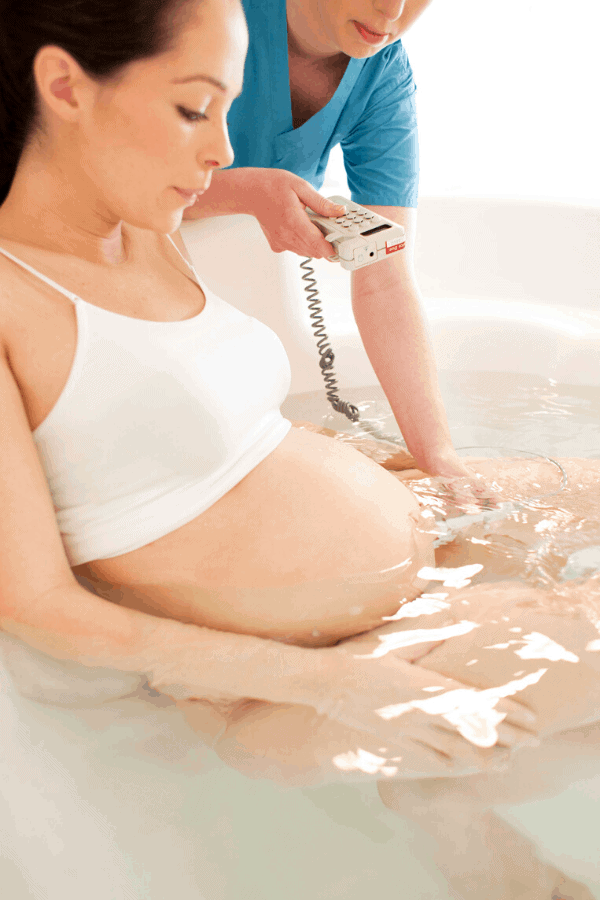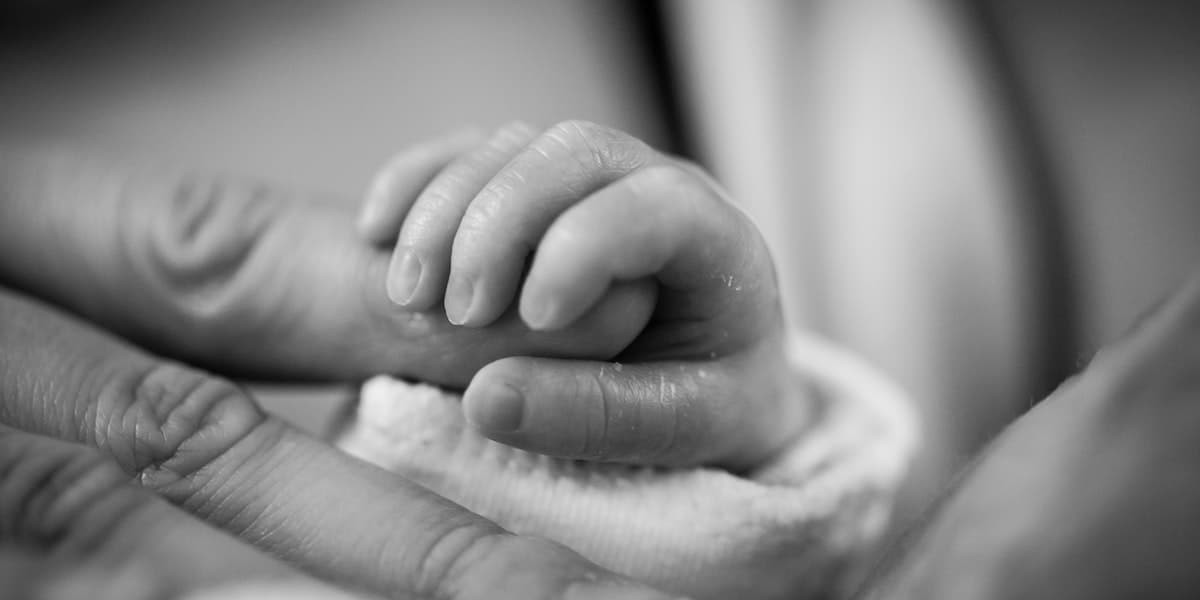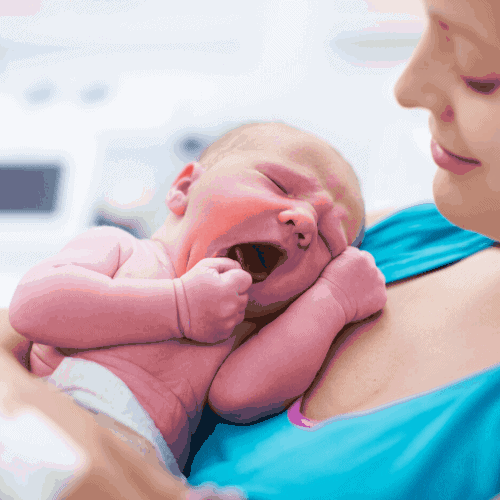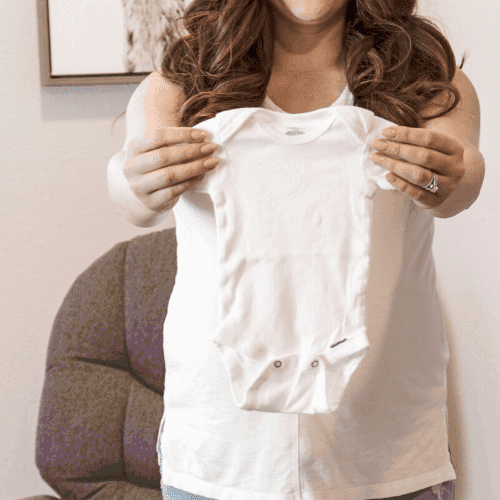Tearing in childbirth can range in different degrees of severity and is very painful. It all depends on your body, not so much on the size of the baby. Some women have tiny baby and tear, while other women birth a big baby and don’t tear at all.
There might be no chance of completely preventing tearing during birth, but you can definitely minimize the risks.
I had an episiotomy with my first baby and a tear with my second. it was so painful. I couldn’t sit down properly for a week afterward and I’m definitely more sensitive down there, too.
As an Amazon Associate I earn from qualifying purchases. The links below may be affiliate links. Please read my disclosure policy for more information
Minimizing The Risks
After my first two experiences, I tried to research and learn as much as I could to prevent having to endure the pain of stitches again. I was able to give birth to 3 very large babies without having any stitches at all.
Let’s begin by discussing why tears happen…
Your baby’s head will descend into the vagina and move down onto the perineum during labor.
The area between your vagina and anus is what is known as the perineal skin and it will thin and stretch over your baby’s head. Your labia and vaginal opening will begin to bulge and stretch as your baby’s head begin to crown.
You will, unfortunately, tear if you find that the skin and perineum haven’t stretched sufficiently enough.
What are the different types of tears?
If you tear, you could be told that you had a second-degree tear, and even though that sounds bad, you don’t actually know what it means. The least common tears are the third and fourth, which can be pretty gruesome.
First Degree
A first-degree tear is an only minor wound. Still painful, but small. It might even be a case of you not needing stitches, which would be great.
Second Degree
A second-degree tear is more serious. In fact, I went through this painful experience with my first child.
Usually, it involves the tearing of both the skin and muscle, which will require stitches.
Third Degree
A third-degree tear is not pleasant in the slightest, to say the least. This degree happens when the tearing area involves the vaginal skin along with the perineal skin and the muscle extending all the way to the anal sphincter (which is the muscle around the anus)
Fourth Degree
The last is definitely the worst, although it seems similar to a third-degree one.
A fourth-degree tear extends deeper into the anal sphincter and the surrounding tissue, sometimes it can actually cause a serious damage impact on how both the anal muscles and the pelvic floor functions.
Related: How to overcome the fear of Labor

6 Risk Factors Of Tearing During Childbirth
1. A Large Baby
If you deliver a heavier baby than average you’re more likely to tear as obviously they tend to have a bigger head than a smaller.
2. A high weight-gain
Try not to give in to that old saying “You’re eating for two!” Although tempting, you’re not actually eating for two, so, please try to remain as healthy as you possibly can.
3. Your age (younger or older moms)
I’m sorry to be the bearer of bad news but, just as a teen mom has a higher possibility to tear, so does an older mom due to their age.
4. Ethnicity
A females’ ethnicity can have an impact in a different way, including vaginal tearing.
This is a strange one, that’s a given. In fact, I’m pretty sure not many people even consider it.
If you’re from Asia, you’ll face a higher possibility of dealing with vaginal tearing during childbirth. The same goes for people with fair skin and ginger hair.
5. Use of assistive devices
If during childbirth you require vacuums or forceps then you’re at a greater risk of vaginal tearing or episiotomies.
Unfortunately, I had to have an assisted delivery with my first child. For this reason, I tried really hard to learn more about childbirth with my second baby to prevent this from happening again.
6. First vaginal birth
Your vagina hasn’t experienced anything like this before. So, cut it some slack.
Although I completely understand your fear and desire* to avoid tearing, if this is your first natural birth, you’ve got to accept that you might have no control over it
Not all hope is lost, though.
They’re things you can actually do to help reduce the risk of tearing.
I have some great tips to help you in your prenatal stage and also during birth to minimize or even prevent tearing.

1. Take a childbirth education class
These classes will be helpful regardless, so they are always worth trying out. The instructors will show you the best birthing positions, how to remain calm during birth, whether you choose to forgo the epidural or not. All of these techniques are going to prevent tearing or at least help lower the chances.
Related: 18 of the Best Online Childbirth Classes Compared
2. Good nutrition
Your skin will increase in elasticity and become able to stretch way more without damage if you have a good nutrition routine.
Of course, all sorts of good foods types are promoted on a daily basis to us and we’re all pretty aware of what is unhealthy to have in our diet.
But the basics remain the same. Always aim to eat plenty of fruits and vegetables along with healthy fats like coconut oil, avocado oils and olive oil.
3. Try to avoid the episiotomy
This is the are the doctors make the cut to create more room for the baby. This has proven to be unnecessary and I’m honestly unsure as to why it’s still being done.
If your doctors start mentioning an episiotomy, which can be because it’s still a common procedure, just say “NO, THANKS”.
Episiotomy can increase the risk of more severe tears and long term perineal, pelvic floor, anal sphincter, and vaginal damage. They’re rarely any benefits of an episiotomy over a natural tear.
Natural tearing often heals better and has fewer risks, accordingly to several studies.
Related: Postpartum Essentials
4. Maternal positioning
Maybe you’ll learn all about this in a childbirth class but I still think it’s useful to make a separate point regarding it.
There will be a reduction in tearing due to your birthing position, believe it or not. If you’re in squatting, kneeling, standing or side-lying position, you’re more likely to go through tear-free childbirth.
Now, if you get an epidural you won’t get to chose this.
You’ll be positioned lying down, that’s just the way it is done. So, if you can’t even deal with a higher risk of tearing it’ll be best to avoid epidurals.
5. Water birthing
Your skin supposedly becomes stretchier when you’re in a warm tub. Because of this, your skin can considerably increase in elasticity.
If you’re thinking about a water-birth, consider it a great alternative as it’s a proven way to avoid a tear.

6. Perineal massage
This is extremely helpful, even if it doesn’t sound like much fun. When you’re recovering from delivery with intact perineum you’ll be thankful to have had one of this massages, believe me.
7. Use a birthing ball
These can help your body’s condition to get ready for giving birth by opening up and stretching your perineum and skin. It’s advised to use one before and during labor. It’s also a brilliant exercise, even though you’re not really doing much.
Related: How to heal quickly postpartum. Using a Padsicle
8. Warm compresses
Warm compresses are there to help warm up the tissue which allows it to stretch really well.
Not only that, but this compresses can also help you by comforting and reducing any pain you might be feeling.
If you don’t have a microwave to warm up a washcloth, then using hot water from the tap is also a great idea.
9. Kegels
Doing Kegels exercises frequently can help build your pelvic floor and vagina.
The blood flow will increase and this can help by making your vagina more relaxed as your baby enters the birth canal.
They’re super worth doing them after childbirth! They also help in to reduce the risk of accidents in those first few months.
10. Controlled pushing during delivery of the baby’s head
By slowly pushing the head out you can help reduce the risk of vaginal tearing, allowing the area to stretch slowly and gently.
This method’s likely going to work better in accommodating the head. Doing this slow-pushing method will allow the baby’s head to move backward and forwards repeatedly.
Yes, I know, I know. It can turn very frustrating and painful for the mom, as it stretches the perineum and releases it, over and over. Just listen to what your body is telling you and remember to breathe.
I believe this was the single most important thing in preventing any tears or cut with my last 3 babies.
Related: How To Take a Postpartum Sitz Bath
11. Your basic instincts
Sometimes it can annoy us, moms, when we get demanded during childbirth, when in fact; all we want to do is what comes naturally to us.
We get told to move our hands, hold our breath, open our legs, not to do this but do this instead.
The list is endless and in labor, we don’t need the pressure of being told what to do unless it is completely necessary.
During my labors, I will admit I only had one nurse who was like this, the rest of them were incredible and really helped me stay calm and allowed me to listen to my own motherly instincts and body.

Be Mindful And Listen To Your Body
You should be listening to your body because you’re the one that’s feeling everything right there. Yes, and you’re the one that’s about to push a beautiful baby out of your vagina. Even though there are times we should listen to the person guiding us, it’s always best to let your own body do the talking.
Educate yourself
There are a few things during labor that you literally have no control over whatsoever, so don’t try to control the situation because won’t be able to. Vaginal tearing can be that part of birth that we don’t have the control over, which sucks!
Related: 18 of the Best Online Childbirth Classes Compared
Just remain as calm as you can.
You can try some of the steps I’ve mentioned to decrease your risk of experiencing vaginal tearing.
Although you will never really know if it worked for you until you’ve given birth.






